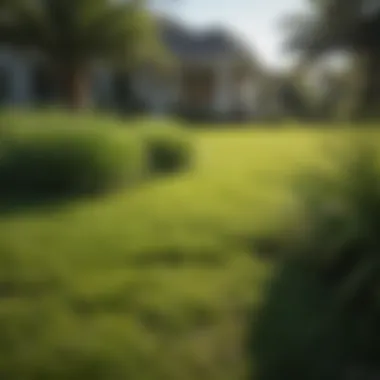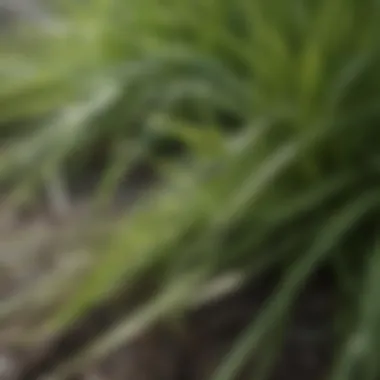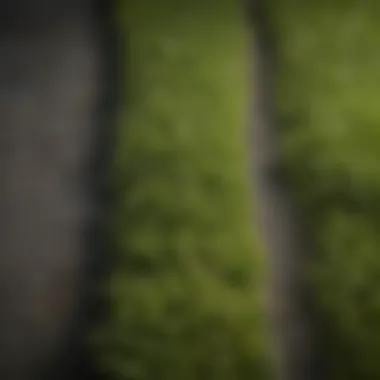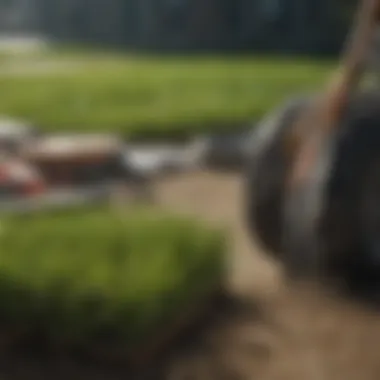Understanding the Cost of St. Augustine Grass


Topic Overview
Definition and Importance
St. Augustine grass is a warm-season turf that is often praised for its rich color and dense growth habit. This type of grass is ideal for lawns in subtropical and tropical regions. The cost of purchasing a pallet of St. Augustine grass can vary significantly, depending on various factors. Understanding these factors is essential for both homeowners who want to cultivate a beautiful lawn and landscapers focusing on lawn care. Knowing the financial implications helps in creating a budget that aligns with personal or business goals.
Brief History and Evolution
Originally, St. Augustine grass is thought to have originated in the West Indies and has since become a staple in southern United States lawns. Over time, several varieties have been developed, each with unique characteristics that suit diverse climates and usage needs. This evolution has not only catered to aesthetic preferences but also improved resilience against diseases and pests. As a testament to its popularity, the demand for St. Augustine grass has remained high, reflecting the ongoing transformation in cultivation practices and consumer preferences.
Key Factors Influencing Cost
Cultivation Methods
The method of cultivation plays a significant role in determining the cost of a pallet of St. Augustine grass. Different approaches yield varying prices based on labor, time, and resource investment. For instance, sod production typically involves more intensive care and monitoring than seed production. Factors like soil preparation, watering, and fertilization contribute to the cultivation method costs.
Regional Pricing Variations
Pricing can drastically differ across regions. Transportation costs, local demand, and availability can lead to fluctuations. For example, areas with abundant grass farms might offer lower prices compared to remote or urban settings where supply is limited. Understanding these regional dynamics can help in making informed purchasing decisions.
Practical Applications
Step-by-Step Guide
To effectively purchase a pallet of St. Augustine grass, consider the following steps:
- Assess your lawn area: Know the size and condition of the area where you plan to plant.
- Research local suppliers: Evaluate different suppliers' offerings and prices.
- Compare varieties: Different St. Augustine cultivars may have different price points and characteristics.
- Plan your budget: Take into account not only the cost of the grass but also delivery and installation if necessary.
- Place your order: Once all comparisons are made, contact your chosen supplier.
Case Studies or Real-World Examples
Many landscapers and homeowners have shared insightful experiences regarding the cost of St. Augustine grass. For example, a homeowner in Florida saved substantially by purchasing directly from a local farm compared to more commercial suppliers. They found that buying in bulk further reduced the cost per pallet. Similarly, a landscaping business reported that diversifying their grass offerings allowed them to leverage competitive pricing for high-demand products like St. Augustine.
"Understanding local demand and supply chain nuances can significantly impact your overall grass purchase experience."
These examples highlight the importance of careful consideration before making a financial commitment. The significance of local dynamics and personal planning cannot be understated for either individual consumers or business entities.
Prelims to St. Augustine Grass
St. Augustine grass is an essential turf choice for many homeowners, especially those living in warmer climates. Understanding its characteristics can guide informed decisions about lawn care and maintenance. This section lays the groundwork for comprehending why more people consider this grass suitable for their outdoor spaces. It highlights benefits like heat tolerance, lush appearance, and comfort beneath bare feet.
Overview of St. Augustine Grass
St. Augustine grass, known scientifically as Stenotaphrum secundatum, is a warm-season turfgrass native to southern USA, Caribbean, and parts of Africa. This grass thrives in tropical and subtropical regions, offering a deep green color and a dense growth habit, making it aesthetically pleasing for lawns. It is commonly used in residential landscapes, golf courses, and recreational areas.
Homeowners are often attracted to its robust nature, which allows it to withstand heat without excessive watering. However, its preference for nutrient-rich soil means proper fertilization is crucial.
Characteristics and Features
St. Augustine grass possesses several distinctive traits that contribute to its popularity:
- Texture and Color: It features broad blades and a rich green hue, contributing to an attractive landscape.
- Growth Habit: The grass spreads through stolons, which help it fill in bare patches effectively.
- Shade Tolerance: Unlike many other grass types, it grows well in partial shade, making it suitable for diverse yard conditions.
- Disease Resistance: While it is generally hardy, St. Augustine grass can be susceptible to specific diseases like gray leaf spot and take-all root rot, highlighting the importance of pest management.
These characteristics are key to understanding the cost associated with purchasing a pallet of St. Augustine grass. The interplay of its unique qualities with various environmental controls impacts pricing and availability.


"St. Augustine grass is not only visually appealing but also offers practical benefits for homeowners."
Factors Influencing the Cost of St. Augustine Grass
Understanding the factors influencing the cost of St. Augustine grass is essential for anyone considering this option for their lawn. The cost can vary considerably based on multiple elements. Being informed about these factors can help homeowners and landscapers make better decisions and plan budgets accordingly.
- Type of Supplier
The choice of supplier plays a significant role in pricing. Suppliers can range from large commercial farms to local nurseries. Large suppliers may offer lower prices due to economies of scale. On the other hand, local suppliers might have higher prices but can provide better customer service and advice tailored to the specific needs of the area. Each supplier will have different grass availability and pricing models, which need careful consideration for planning a purchase. - Quality of Grass
The quality of St. Augustine grass is a critical factor. Not all grass is created equal, and the cost will reflect this variance. Premium quality grass that has been well-cultivated and cared for will typically come at a higher price. Lower quality grass might be cheaper but can lead to additional costs in maintenance and replacement. Assessing the quality involves looking at the health of the grass, its density, and its overall appearance. Choosing wisely here can affect long-term satisfaction with the lawn. - Geographical Location
The location where the grass is purchased significantly affects its price. In regions where St. Augustine grass is less common, transportation costs add to the price. Conversely, areas where the grass is naturally suited will often have competitive pricing. Local climate conditions can also influence the type of grass available and its pricing. Regions with more temperate climates may offer a wider variety of grass at lower prices than colder regions. - Seasonal Variations
Seasonal fluctuations can affect the availability and cost of St. Augustine grass. During peak growing seasons, supply can diminish as demand rises, leading to price increases. Conversely, during off-peak seasons, prices may drop as suppliers look to move inventory. Identifying the best time to purchase St. Augustine grass can lead to significant savings while also ensuring fresher, more robust grass.
"The cost of St. Augustine grass can be substantially altered by understanding the type of supplier, quality, location, and seasonal timing."
In summary, being aware of these factors can lead homeowners and landscapers to make informed choices. Each aspect intertwines with others, leading to variations in price that can influence overall costs for achieving a vibrant lawn.
Typical Price Range for St. Augustine Grass Pallets
Understanding the typical price range for St. Augustine grass pallets is crucial for anyone looking to invest in this turf variety. It is not just about the initial cost; it also provides insights into the overall value and long-term maintenance expenditures. A clear grasp of the pricing can help homeowners and landscapers plan their budgets effectively and ensure they are making informed decisions. Different factors play a role in determining the price, including national averages and regional variations.
National Averages
National average prices serve as a reliable benchmark when evaluating costs associated with St. Augustine grass. Generally, the price per pallet typically ranges from $200 to $500. This cost may already include delivery options depending on the supplier.
Here are specific points to consider regarding the national average for St. Augustine grass:
- Grass Quality: Higher-quality grass can command prices toward the upper end of the spectrum.
- Quantity Discounts: Purchasing multiple pallets may result in savings, impacting the overall price.
- Market Trends: Seasonal factors, such as planting time, can influence fluctuations in pricing.
It's beneficial to compare local suppliers against this national average to gauge whether you are getting good value.
Regional Price Differences
Prices for St. Augustine grass can vary significantly across different regions. Factors contributing to these differences include local demand, climate conditions, and supply chain logistics. For example, in southern states where St. Augustine is widely popular, you might find prices lower due to competitive supply. Conversely, in northern regions where St. Augustine grass is less common, prices can be higher due to transportation costs and limited availability.
Some relevant regional factors include:
- Climate: Warm-weather states may offer more competitive pricing.
- Demand and Supply: Higher local demand can drive prices up, especially during peak seasons.
- Local Regulations and Taxes: Some areas may impose additional costs through regulations that can affect the overall price.
"Understanding regional variations in price is essential when considering investment in St. Augustine grass."
Purchasing decisions should consider these regional differences to avoid unnecessary costs. Whether you focus on national averages or regional pricing, knowing both will equip you to make savvy choices about investing in St. Augustine grass.
Comparative Cost Analysis
Understanding the comparative cost analysis of St. Augustine grass relative to other grass types is essential for making informed choices. This section delves into what makes St. Augustine grass unique in terms of pricing and how it competes with alternatives. It highlights various elements such as price differences, benefits, considerations, and target audience needs.
St. Augustine Grass vs. Other Grass Types
St. Augustine grass is often compared to other popular turf grasses like Bermuda, Zoysia, and Kentucky Bluegrass. Each has its unique characteristics affecting cost and usability.
- Bermuda Grass: Generally cheaper, Bermuda grass is favored for its drought resistance. However, its rapid growth can increase maintenance costs.
- Zoysia Grass: A slow grower, Zoysia can have higher establishment costs, but it often requires less watering. It provides a dense, plush lawn but may not be a cost-effective option for everyone.
- Kentucky Bluegrass: Known for its rich color, its average upfront cost can exceed that of St. Augustine. It requires cooler climates and more maintenance, which can offset its appealing appearance.
When comparing costs, consider both initial expenses and long-term maintenance. The user's climate, lawn preferences, and maintenance abilities play significant roles in deciding which type of grass may be more economical.
Cost of Establishment and Maintenance
The initial cost of establishing St. Augustine grass typically includes the price of the pallet, any soil amendments, and labor, if hired. Maintenance costs can vary based on several factors:


- Watering Needs: St. Augustine grass has moderate water requirements, affecting utility costs. In regions prone to drought, it may incur higher costs due to irrigation needs.
- Fertilization and Pest Control Expenses: Regular fertilization and occasional pest control are essential for healthy growth. On average, costs tend to fluctuate based on the products used and the frequency of treatment.
- Mowing and General Upkeep: Regular mowing, edging, and aeration are crucial for maintaining aesthetic appeal, adding to overall costs.
In summary, while St. Augustine grass may have a higher upfront cost compared to some other grass types, understanding its long-term maintenance requirements and potential benefits can be essential for a homeowner's final decision.
"Investing in St. Augustine grass can yield a lush, green lawn, but knowing all associated costs is best for budget planning."
This comparative analysis provides clarity on what to expect financially when laying down your lawn. Making informed decisions ensures better returns on investment and satisfaction in your gardening endeavors.
Purchasing Options
When considering the cost of a pallet of St. Augustine grass, understanding the various purchasing options is essential. This section explores retail and wholesale avenues, online platforms versus local suppliers, and the benefits associated with each choice. The purchasing options not only influence the price but also affect the overall experience of acquiring this popular turf type. Evaluating these elements can help you make an informed decision, ensuring that your investment yields positive returns.
Retail vs. Wholesale
Purchasing St. Augustine grass from retail sources generally provides convenience and accessibility. Retail options, such as garden centers and home improvement stores like Home Depot or Lowe's, give consumers the chance to physically assess the quality of the grass before buying. This tangible experience can help buyers ensure that they are selecting healthy and robust sod.
However, retail prices can often be higher because of added overhead costs. The selection may also be limited based on seasonality or store inventory.
On the other hand, wholesale suppliers typically offer lower prices since they deal in bulk. Purchasing from wholesalers can be economically advantageous for landscapers or large projects, where significant quantities of grass are needed. However, this option may require some logistical planning, as picking up sod from a wholesale supplier may involve transportation challenges.
In summary, consider the scale of your project and financial capabilities when choosing between retail and wholesale.
Online vs. Local Suppliers
In the digital age, purchasing St. Augustine grass online has become increasingly popular. Many online suppliers provide detailed information about their products, competitive pricing, and often convenient delivery options. Engaging with online retailers and platforms like Amazon or specialized lawn care websites can be easy and efficient, especially for those who value time and convenience.
However, purchasing online requires a degree of diligence. Buyers cannot physically inspect the grass and must rely on images and descriptions from the supplier. It’s crucial to read customer reviews and ensure that the retailer has a sound reputation to avoid receiving lower-quality products.
Conversely, local suppliers allow for direct interaction and often a hands-on selection of sod. Visiting a local nursery or garden center gives you an opportunity to ask questions and receive personalized advice from knowledgeable staff.
Ultimately, weighing the pros and cons of each purchasing route is vital. Your choice may depend on your personal preferences, the urgency of your project, and potentially the specific qualities of the St. Augustine grass you wish to obtain.
"Choosing the right purchasing option can significantly impact both costs and satisfaction levels in your grass investment."
Assessing Value for Money
Assessing value for money in relation to a pallet of St. Augustine grass is crucial for homeowners and landscapers alike. This process involves evaluating not just the initial cost of the grass but also the long-term benefits and expenses. This section discusses specific elements that can help gauge the overall value of investing in St. Augustine grass.
Lifetime of St. Augustine Grass
The longevity of St. Augustine grass is a vital aspect of its value. On average, if properly cared for, this grass type can last up to 20 years. Factors affecting its lifespan include weather conditions, soil quality, and maintenance practices. Regular watering, proper fertilization, and pest control can significantly enhance its durability.
The potential for St. Augustine grass to establish a thick, healthy lawn also plays into its value proposition. A well-maintained lawn can deter weeds and pests, reducing the need for additional treatments. Homeowners should factor in these long-term benefits when considering the purchase of a pallet of grass. Investing upfront in quality grass can yield a lush lawn that requires less intervention over time.
Return on Investment for Homeowners
Calculating the return on investment (ROI) from St. Augustine grass is essential for homeowners seeking cost-effective landscaping solutions. When considering ROI, homeowners should evaluate both aesthetic and economic factors.
- Aesthetic Appeal: A lush lawn increases the visual appeal of properties. This can enhance overall property value, making it more attractive to prospective buyers.
- Maintenance Savings: High-quality St. Augustine grass often demands less maintenance than lower-quality options. This translates to savings over the lifespan of the lawn.
Investing in St. Augustine grass may require a higher initial outlay. However, the reduced maintenance costs and increased property value can validate this choice. Homeowners should thus weigh these elements to make an informed decision.
"Quality grass can significantly lower maintenance needs and foster a vibrant lawn while adding to overall property value."


Maintenance Costs Associated with St. Augustine Grass
The maintenance costs of St. Augustine grass are fundamental to understanding the true financial investment this turf requires. This section will explore the primary elements involved in its upkeep, ensuring homeowners and landscapers can prepare for the real costs of maintaining this popular lawn choice.
Watering Needs
Watering is crucial for St. Augustine grass to thrive, particularly in warmer climates. The grass type prefers consistently moist soil, which typically translates into regular watering schedules. Generally, St. Augustine grass needs about 1 to 1.5 inches of water per week, depending on the local climate and conditions. In hotter areas, this rate may increase.
Here are key points about watering needs:
- Frequency: Water should be applied at least two to three times a week, more during peak summer months.
- Methods: Irrigation systems, such as sprinkler systems or drip irrigation, can provide efficient water delivery but come with initial installation costs.
- Cost Implications: Water bills can add up, especially in regions where water is scarce or expensive. It's important to calculate these ongoing expenses when budgeting for lawn maintenance.
Fertilization and Pest Control Expenses
Fertilization is essential for promoting healthy growth and maintaining the lush appearance of St. Augustine grass. The specific costs depend on the type of fertilizer used and the frequency of application. Regular fertilization typically occurs every six to eight weeks during the growing season.
- Type of Fertilizer: A balanced fertilizer with a ratio of nitrogen, phosphorus, and potassium is often recommended. Natural fertilizers can also be an effective alternative, but may vary in price.
- Pest Control: Alongside fertilization, pest control is another important factor. St. Augustine grass is susceptible to a range of pests such as chinch bugs and grubs. Addressing pest problems may involve treatments that can be costly, particularly if multiple applications are necessary.
- Cost Factors: The overall expense can fluctuate based on the treatment chosen, the severity of infestations, and whether a professional service is employed.
Investing in proper irrigation and pest management is essential for maximizing the lifespan and vitality of St. Augustine grass, making these recurring costs significant in any long-term lawn care plan.
Environmental Considerations
Understanding the environmental considerations associated with St. Augustine grass is essential for responsible landscaping and sustainability. This section delves into two critical elements: water usage and sustainability factors, highlighting their impact on the overall cost and benefits of choosing this particular grass type.
Water Usage
St. Augustine grass is known for thriving in warmer climates, yet it has specific watering needs that homeowners must consider. This grass variety typically requires more water than other types, especially during the initial establishment phase. For optimal growth, it demands about 1 to 1.5 inches of water per week, delivered through irrigation or rainfall.
Here are some key aspects of water usage:
- Irrigation Frequency: During dry spells or drought conditions, more frequent irrigation may be necessary. This increases overall costs, particularly in areas where water restrictions are in place.
- Soil Type: The type of soil can affect how much water is needed. Sandy soils drain quickly and may require more frequent watering compared to clay soils, which retain moisture longer.
- Evapotranspiration Rates: In hotter climates, rates for evapotranspiration can be high. Homeowners should consider seasonal variations in temperature and humidity when planning a watering schedule.
Proper water management can reduce costs significantly and enhance the growth and durability of St. Augustine grass.
Sustainability Factors
When assessing St. Augustine grass, sustainability is a crucial consideration in the context of environmental impact. Here are some factors to reflect on:
- Native Species: St. Augustine grass is not a native species in many regions, which raises questions about its ecological impact. Homeowners might consider native alternatives that require less water and fertilizer.
- Pesticide Use: St. Augustine grass may be susceptible to pests and diseases, necessitating chemical applications. Reducing pesticide use benefits local ecosystems and can lower overall costs, promoting healthier soil and water systems.
- Long-term Viability: Sustainable landscaping means considering the longevity of the grass. If homeowners frequently reseed or replace their lawns due to poor growth, the long-term financial and environmental costs increase.
Incorporating these environmental elements enhances a homeowner's decision-making process. While St. Augustine grass may be visually appealing and suitable for many landscapes, understanding its environmental implications is vital to making an informed choice.
Epilogue
A critical part of the conversation centers on the value that St. Augustine grass can bring to residential and commercial landscapes. It is crucial for homeowners and landscapers to balance initial costs with factors like maintenance requirements and environmental impact, ultimately affecting long-term satisfaction with this grass type. Evaluating how these costs align with project goals can have significant influence on determining the right choice for personal or professional use.
"Investing in quality grass is an investment in the health and beauty of your outdoor space."
In summary, touching upon the right pricing and the appropirate supplier while considering maintenance is necessary for effective decision-making processes regarding St. Augustine grass. This understanding enhances the investment experience, as homeowners and professionals alike can take pride in a beautiful, vibrant landscape crafted through informed choices.
Summary of Key Points
- Factors Influencing Cost: The cost of a pallet can vary based on factors such as the type of supplier, quality of grass, and geographical location.
- Pricing Variations: Price ranges differ significantly across regions and might fluctuate based on seasonal availability.
- Value for Money: St. Augustine grass is often associated with robust value when considering its visual appeal and durability.
- Maintenance Considerations: Watering and fertilization needs play a role in assessing overall expenses and satisfaction with the turf.
Final Thoughts on Cost vs. Benefit
When evaluating the cost versus the benefits derived from investing in St. Augustine grass, it is imperative to consider both short-term expenses and long-term implications. The initial outlay for a pallet might seem high but can translate into a lush landscape over time, enhancing property values and outdoor enjoyment.
Potential buyers should weigh aspects such as maintenance demands against the benefits of having a resilient and attractive lawn. Homeowners in warmer climates will likely find that the advantages of St. Augustine—like drought resistance and adaptability to various soil conditions—can justify the costs incurred.
Ultimately, understanding these nuances can empower individuals to make decisions that resonate with their personal and financial goals.



